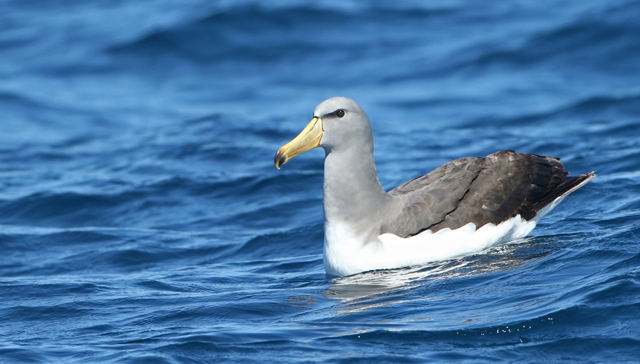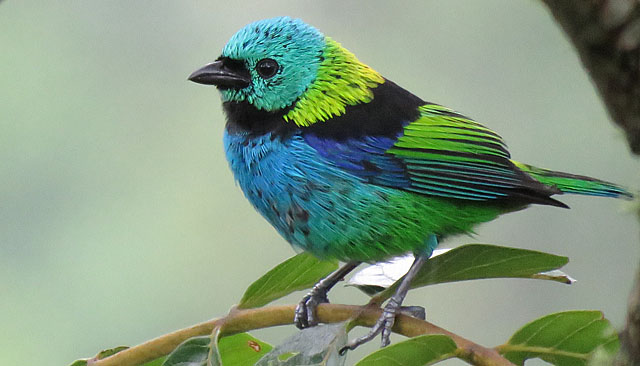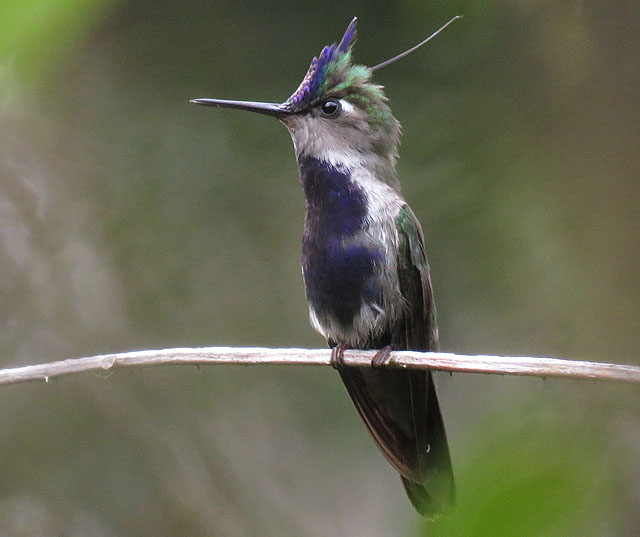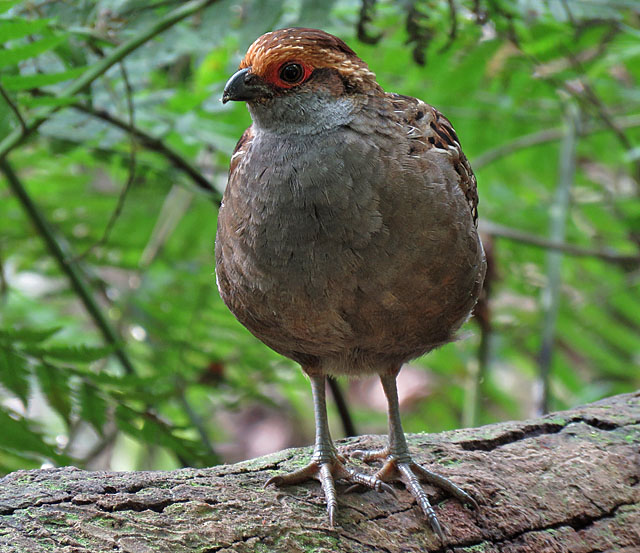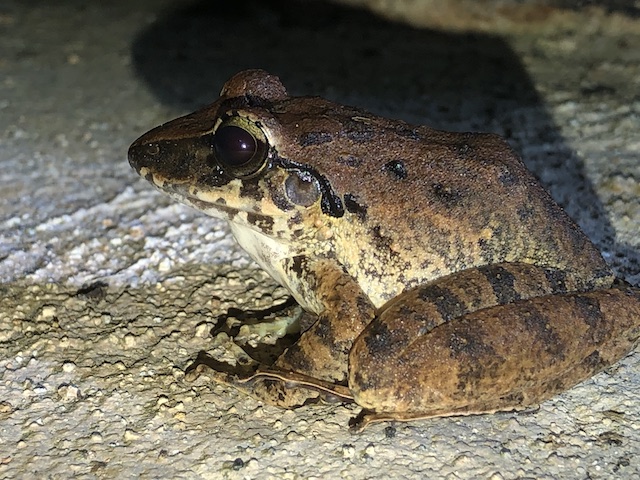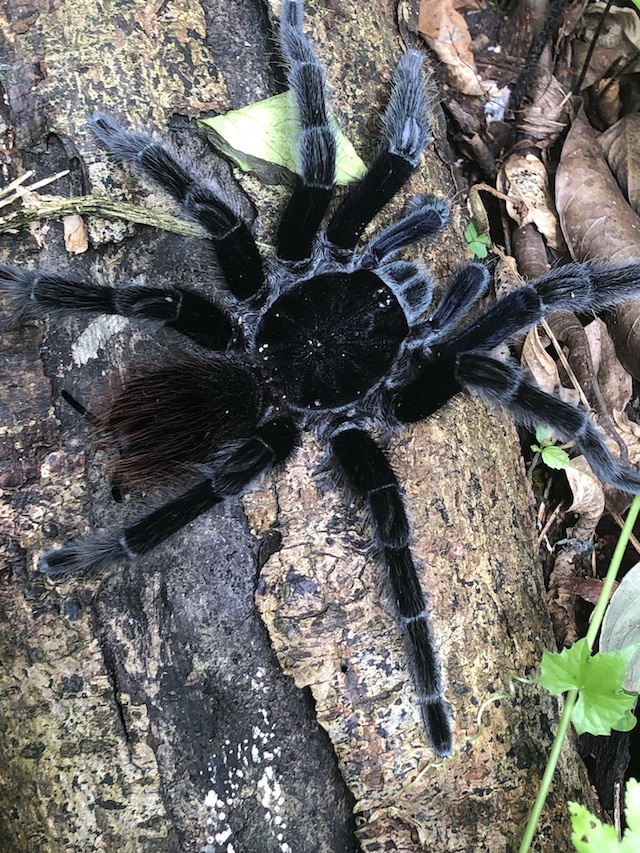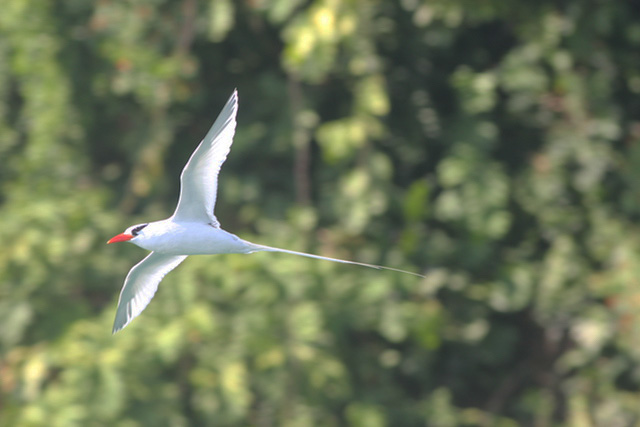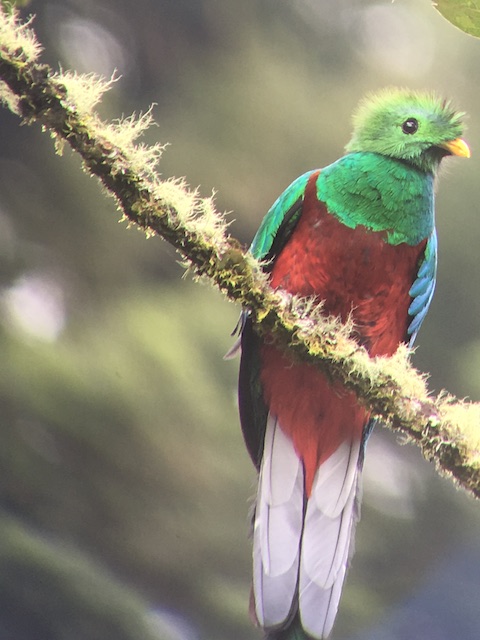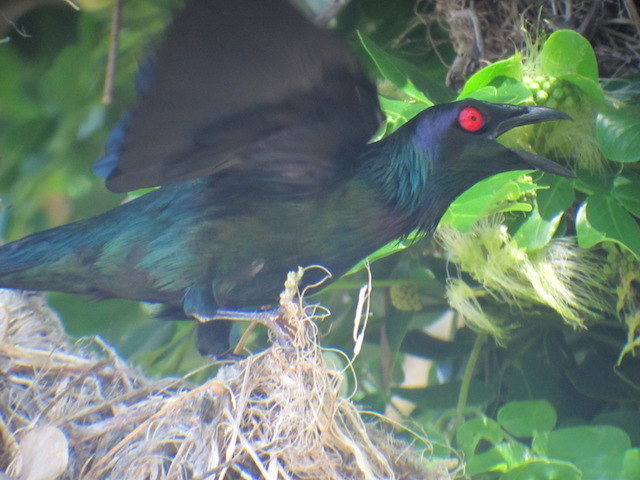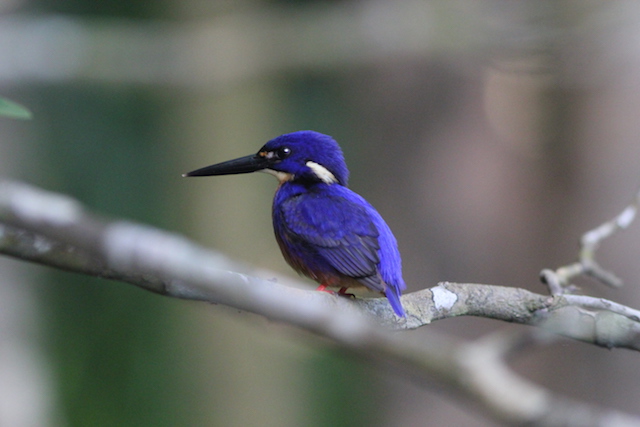From the Field
January 14:
Rich Hoyer on his recently completed tour, Brazil: The Southeast Atlantic Rainforest
So many endemic birds – either stunningly beautiful or with fascinating and evocative vocalizations – made our tour of the Atlantic rainforests of Brazil’s Rio de Janeiro and São Paulo states memorable and fun. Ridiculously colorful tanagers and sparkling hummingbirds vied for our attention, skulking antbirds and gnateaters teased us, and feeders made for some easy birding. The sounds of several Bare-throated Bellbirds echoing across the hillsides with Hooded Berryeater and White-browed Warbler ringing through the forest provided for a sensation that isn’t repeated anywhere else in South America. We tallied an impressive 350 species of birds seen and another 20 heard, as well as many interesting plants, insects, reptiles, and other critters. Such a big list means we also worked on teasing out the many obscure tyrannulets, and SE Brazil is full of them. A Pavonine Cuckoo at arm’s length on our next-to-last day was voted tour favorite, fantastic to watch it utter its soft song of six whistled notes. Other species getting top votes included a pair of giant Robust Woodpeckers, an exciting flock of Scarlet Ibises, very attractive Bay-chested Warbling-Finches, and a ridiculously cooperative Red-and-white Crake.
At our first birding area north of Rio de Janeiro we snagged the very local Three-toed Jacamar and Gray-winged Cotinga with a great deal of luck, despite fog and a sudden shower. The weather was unusually cool, so insect activity was rather subdued, but we did marvel at the beauty of this cicada, Carineta diardi.
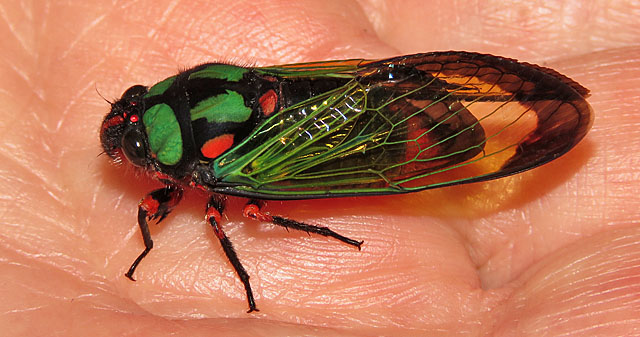
At our birding stop at REGUA, a Chestnut-backed Antshrike pair was feeding a recent fledgling at the close-focus limit of our binoculars.
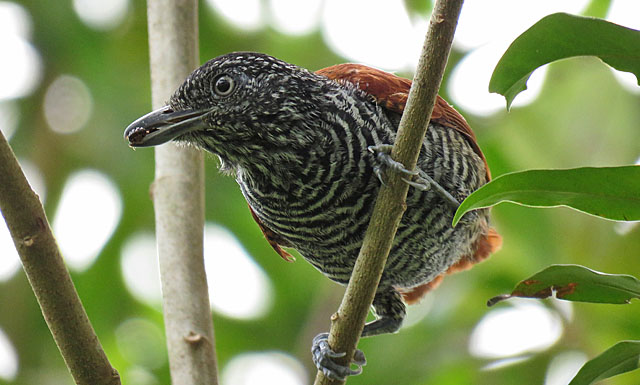
A day and a half of rain at Itatiaia National Park “forced” us to spend more time watching the feeders on the hotel balcony where Green-headed Tanager showed off its colors.
Red-breasted Toucan also appeared a few times to sample the fruit put out by the restaurant workers.
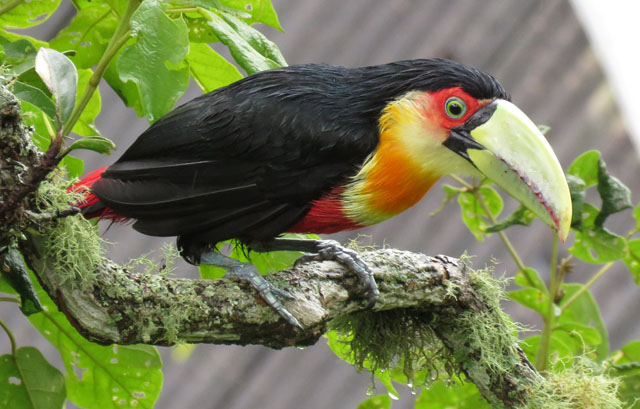
The coastal lowlands and foothills of São Paulo were very productive, with antbirds, gnateaters, and many hummingbirds. On one birdy morning walk we took advantage of a break in the bird activity to admire this gorgeous orchid, Gongora bufonia.
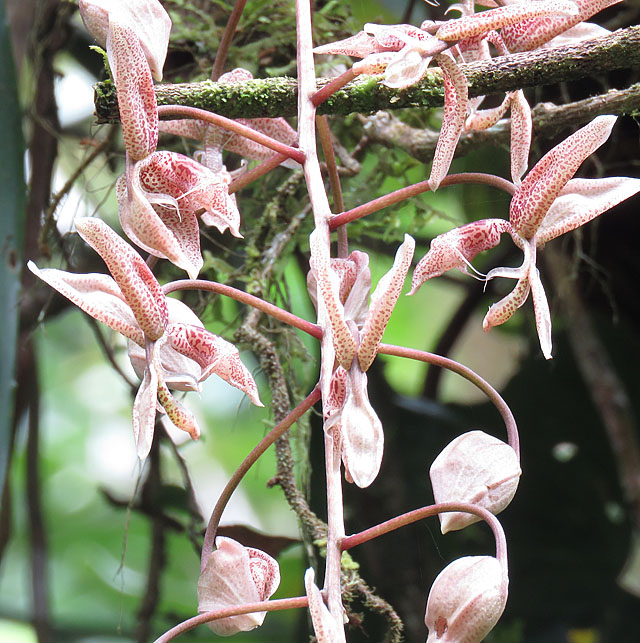
We finished the tour at the amazing Intervales State Park, and our local guide Renato was a fantastic help with his super sharp ear and local knowledge of recent sightings. This Common Potoo was on a roost it had been using for a few days.
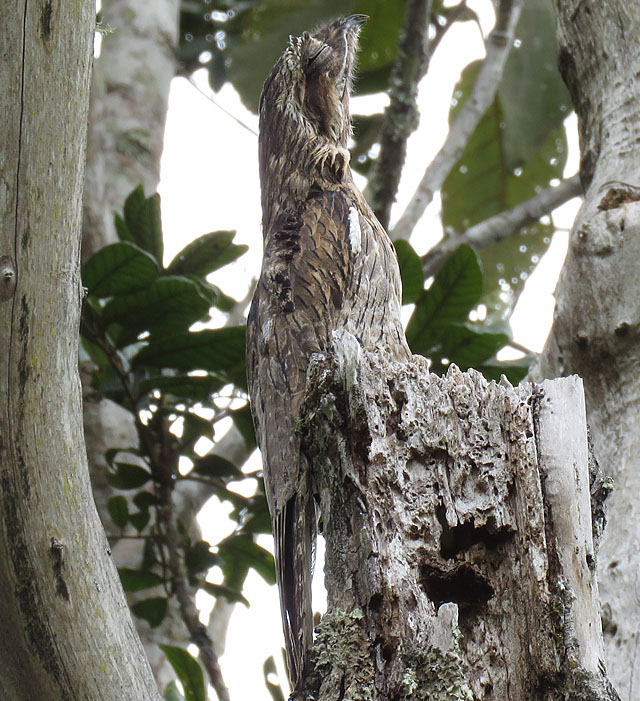
We visited a double lek of Dusky-throated Hermits and Purple-crowned Plovercrests (below), both of which cooperated nicely for us.
A feeding station hidden on a narrow forest trail hosted an acclimated family of the rarely seen Spot-winged Wood-Quail, and we had superb looks at these elusive birds.
December 19:
Gavin Bieber on his recently concluded tour, Panama: Darién Lowlands
The vast and sparsely populated Darien Province in the far east of the country contains some of the most remote and wild lowland and montane wilderness remaining in Central America. Our base for the week was the newly constructed and very comfortable Canopy Camp
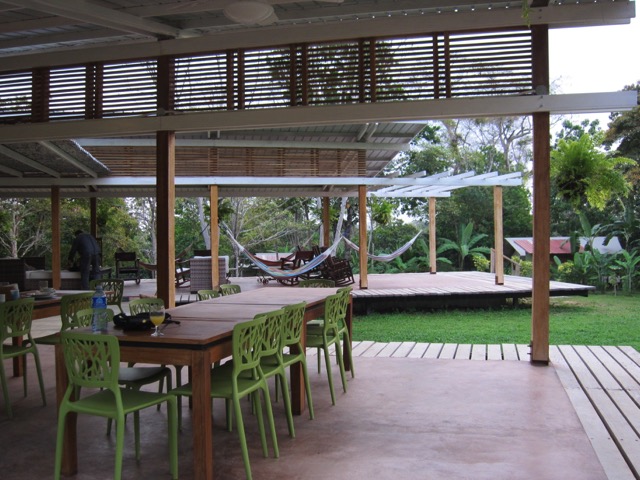
The Canopy Camp commons area
We spent several days exploring the camp trails and various spots along the end of the Pan-American highway, where patches of forest and more open fields revealed widespread birds such as King Vulture, and more localized ones such as the impressive Barred Puffbird, the attractive Spot-breasted Woodpecker and the globally scarce Black Oropendola.
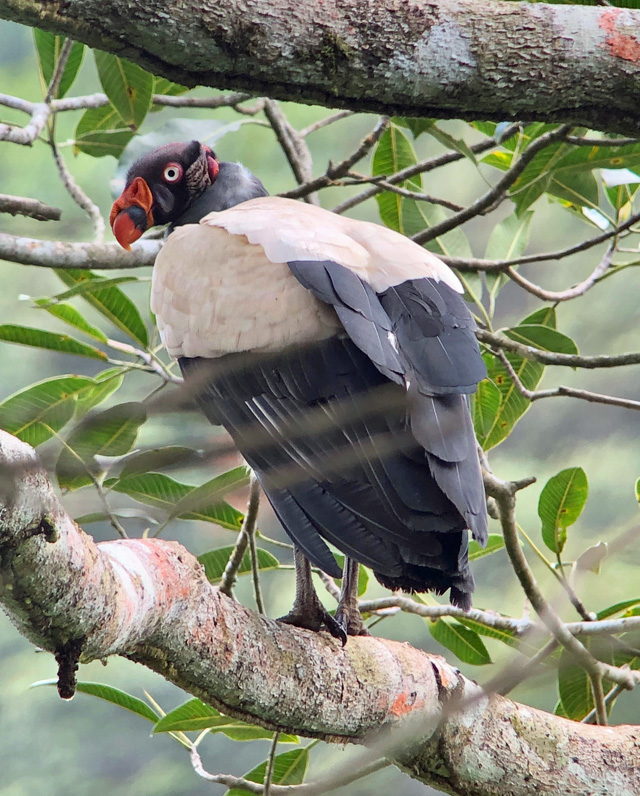
A splendid King Vulture
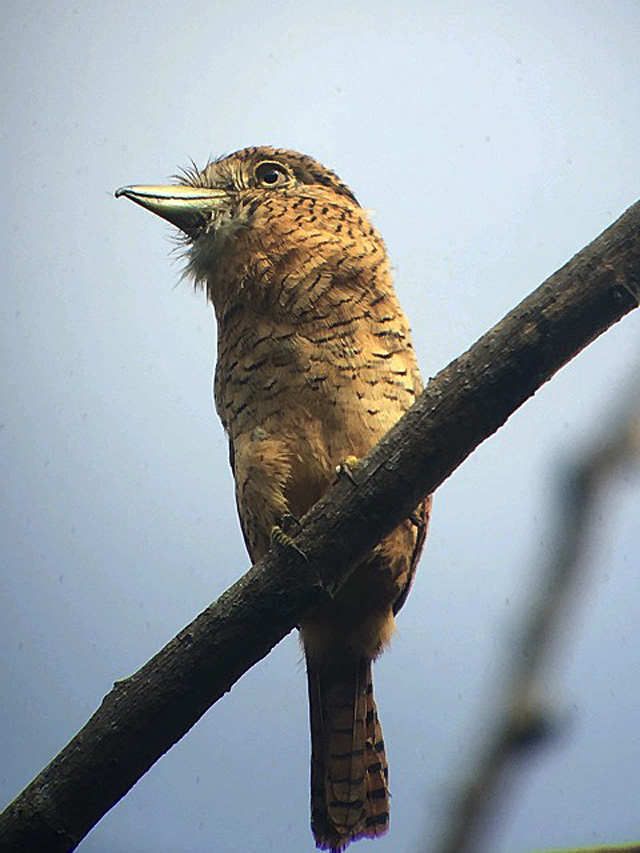
Barred Puffbird
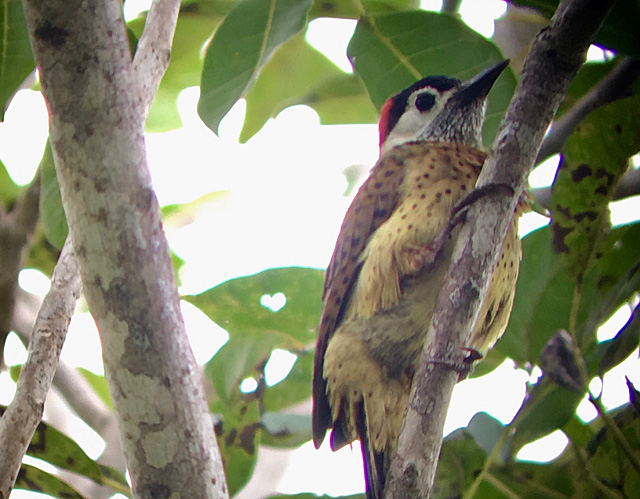
Spot-breasted Woodpecker
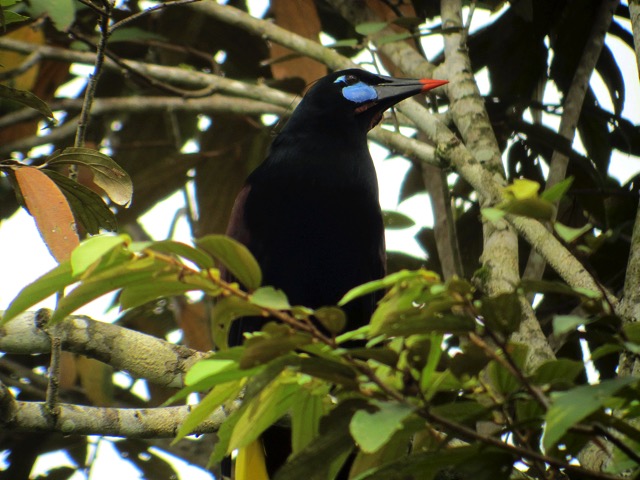
A range-restricted Black Oropendola
A few stray non-birds crossed our path too, such as this placid Craugastor sp. Frog and an impressively large tarantula.
An imperturbable frog>
A glossily handsome and large tarantula
Taking dugout canoes out into Embera territory past the end of the road allowed us to visit a known nest site of the incomparable Harpy Eagle, surely the highlight species of the trip for most.
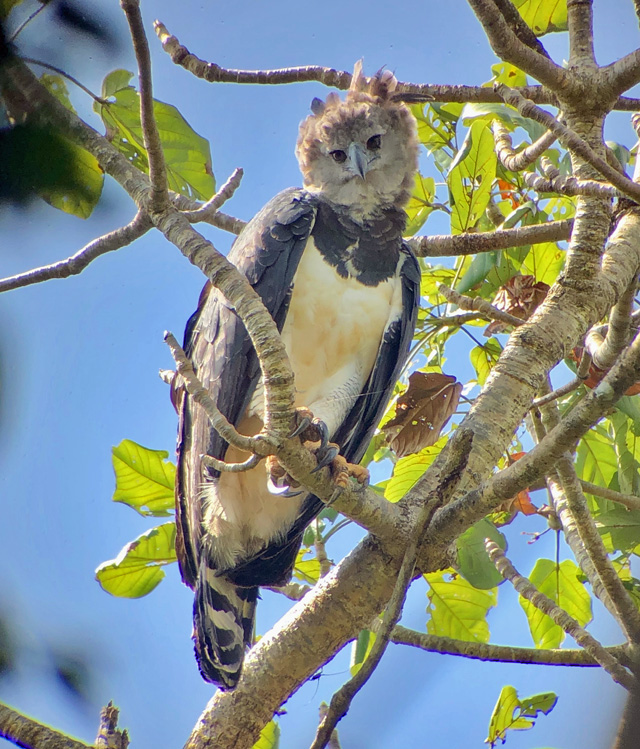
A magnificent Harpy
Over the course of the week we encountered 262 species of birds including 16 species of antbirds, an impressive 14 species of herons and 34 species of everyone’s favorite bird family; the new world flycatchers! These areas in the Darien are little explored and I am sure that the creation of a comfortable lodge here will produce a lot of new discoveries. I very much look forward to returning next fall!
December 16:
Steve Howell on his recently completed tour, Mexico: The Yucatan and Cozumel
It was another wonderful Mexico tour to The Yucatan and Cozumel, and a week of hot sunny weather filled with birds, great food, and friendly people.
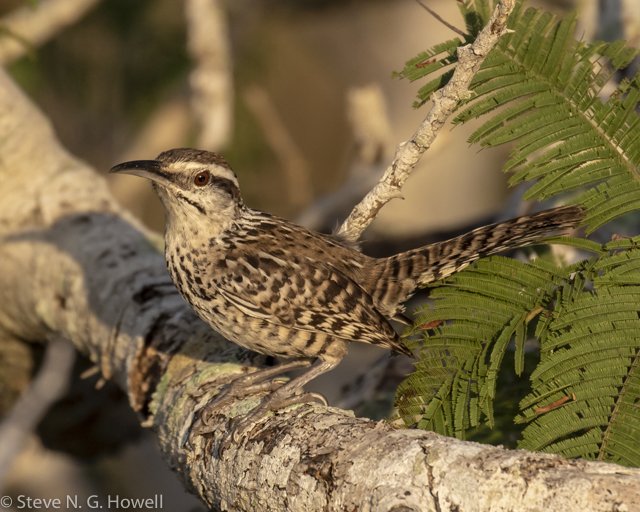
We saw basically all of the regional endemics, including the very local Yucatan Wren...
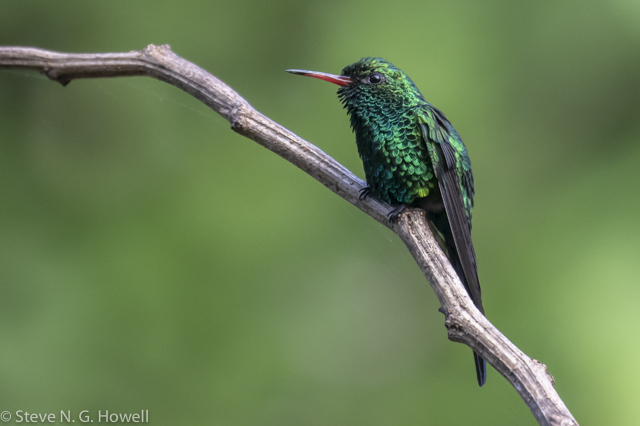
And the dazzling Cozumel Emerald, endemic to the island of the same name.
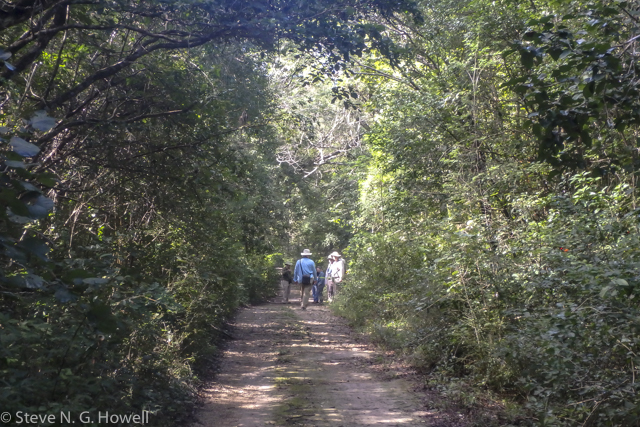
Birding on a quiet road along a green tunnel through the forest...
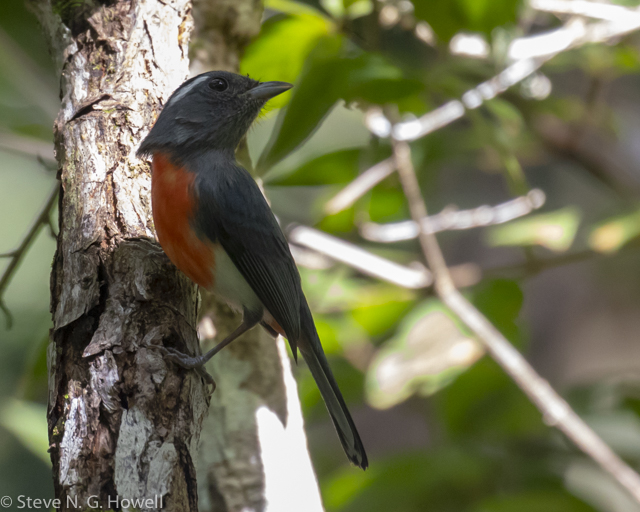
We found the enigmatic Gray-throated Chat, formerly a warbler, now treated as a Cardinalid ‘grosbeak’!

As well as the handsome Gray-headed Tanager (still a tanager!)
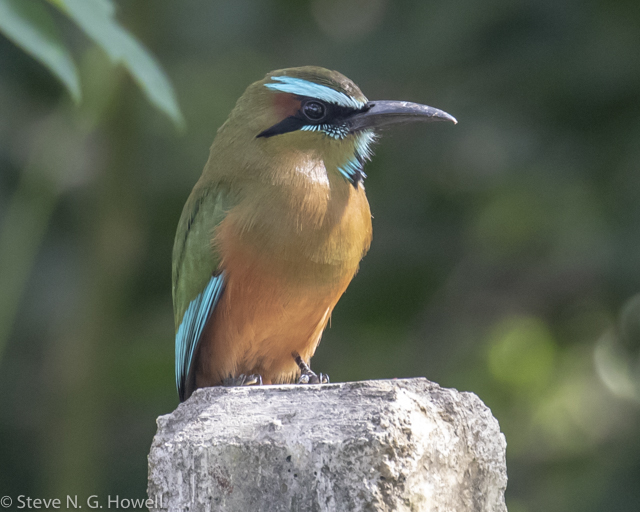
A sun-drenched Turquoise-browed Motmot outshone the ruins at Chichen Itza,
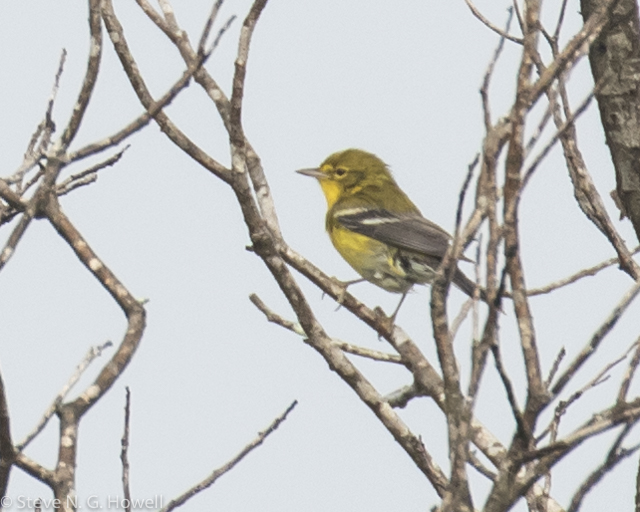
And we even ended the trip with a real rarity, a Pine Warbler on Cozumel!
December 14:
Gavin Bieber on his recently completed tour, Panama: Bocas del Toro and the Western Highlands
It’s testament to the diversity of habitats and birds that exist in this relatively small geographic area that over the course of eight birding days we detected 330 species between the Caribbean lowlands and Pacific-slope Highlands. We started out in the Bocas del Toro Archipelago, where the semi-aquatic town of Bocas served as our access point to the idyllic Tranquillo Bay Ecolodge.
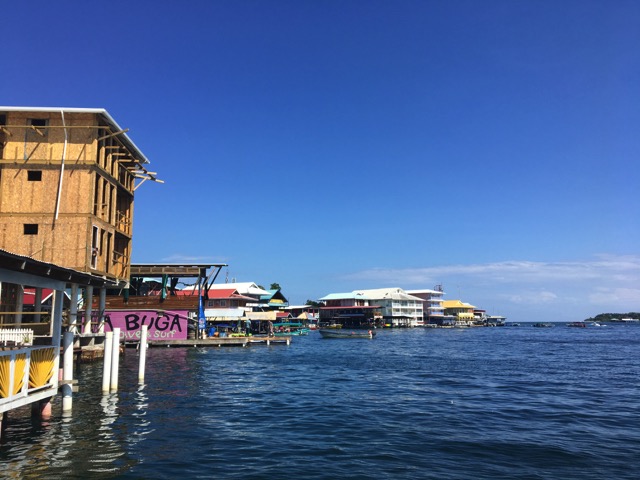
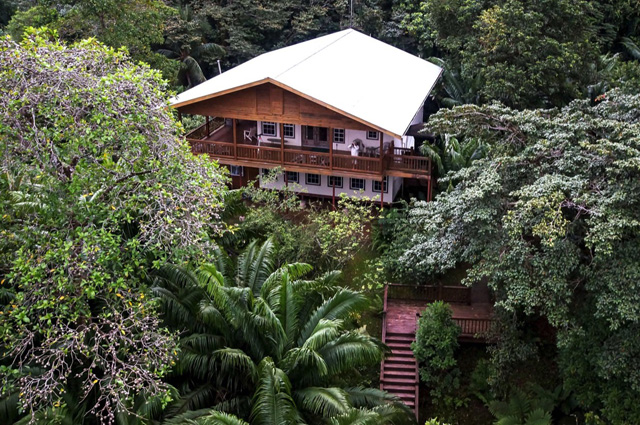
Traveling largely by boat (we ventured out to other islands and the adjacent forested lowlands where we were introduced to a wealth of birds and other animals (like this handsome Strawberry Dart Frog) amid the picturesque archipelago and humid Caribbean foothills.
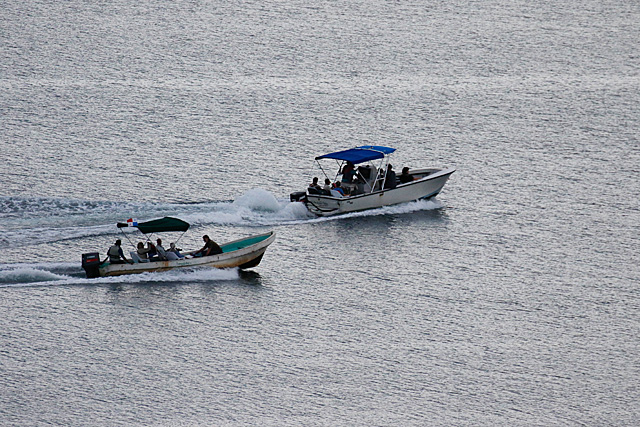
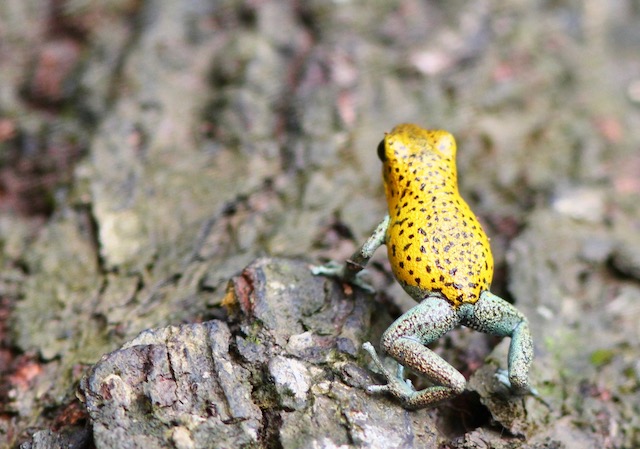
Perhaps the highlight birds of the first few days this year were the ethereal Red-billed Tropicbirds that we witnessed doing display flights at a small offshore colony.
The second half of the trip visited the cool and heavily forested highlands around the impressive 11,400 foot Baru Volcano where new birds like Resplendent Quetzal, Volcano Hummingbird and the impressive Violet Sabrewing awaited.
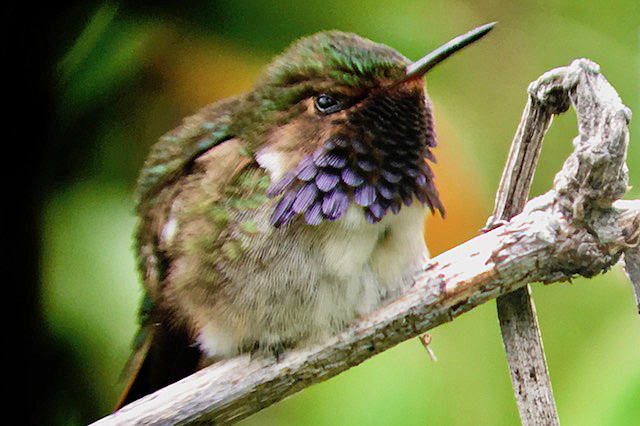
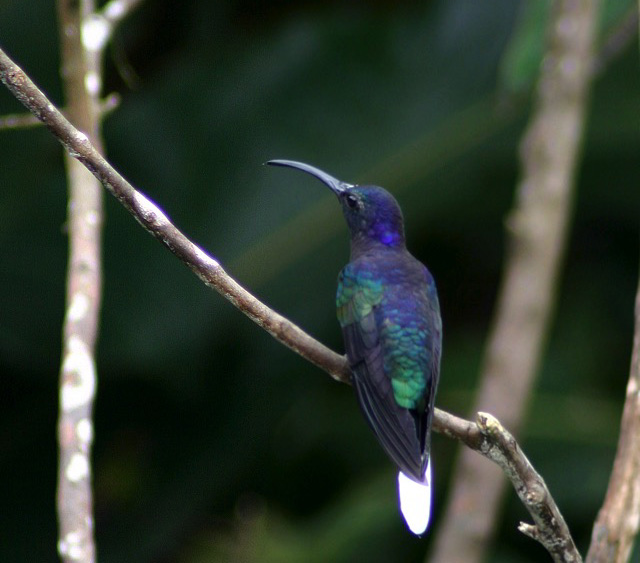
Our last day was down in the pacific lowlands where we eventually caught a return flight to Panama City from the town of David, but not before finding a flock of Fiery-billed Aracaris!
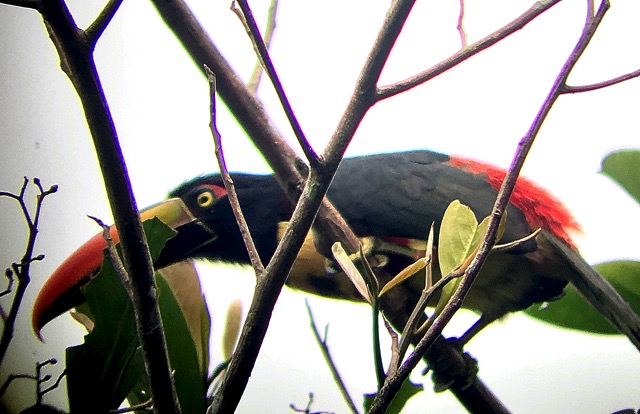
I very much look forward to returning to this dynamic and bird-rich region.
December 12:
Gavin Bieber on his recently completed tour, Panama: Fall at the Canopy Tower
Our fall 2018 trip was packed with birds and several charismatic mammals. On our first afternoon we spotted a distant male Blue Cotinga glowing from the canopy, later in the trip we had this handsome male much closer near the top of Cerro Azul.
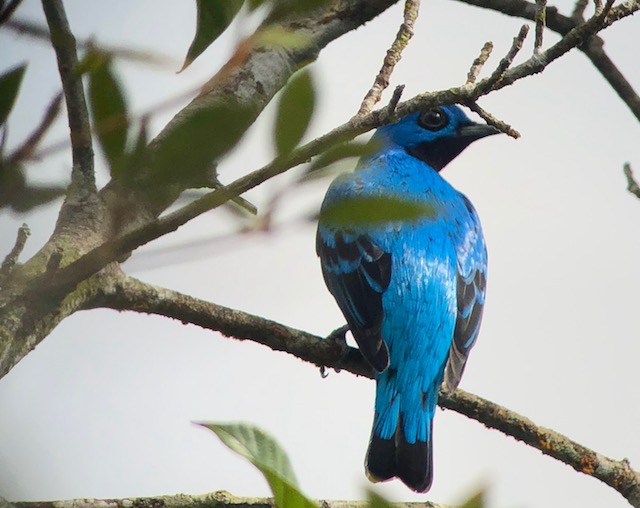
Around the tower we located well over two hundred species of birds, including this sleeping Black-and-White Owl and this inquisitive White-whiskered Puffbird.
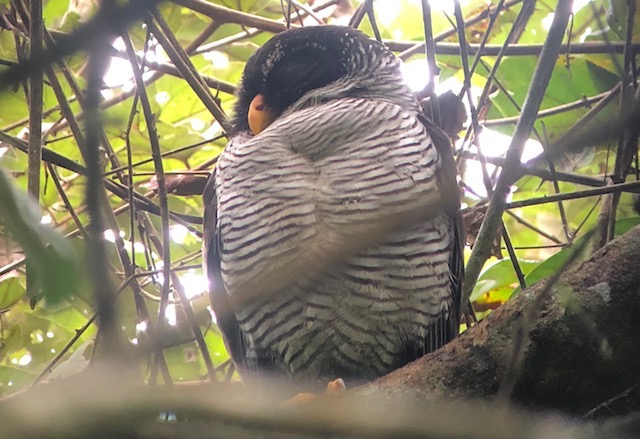
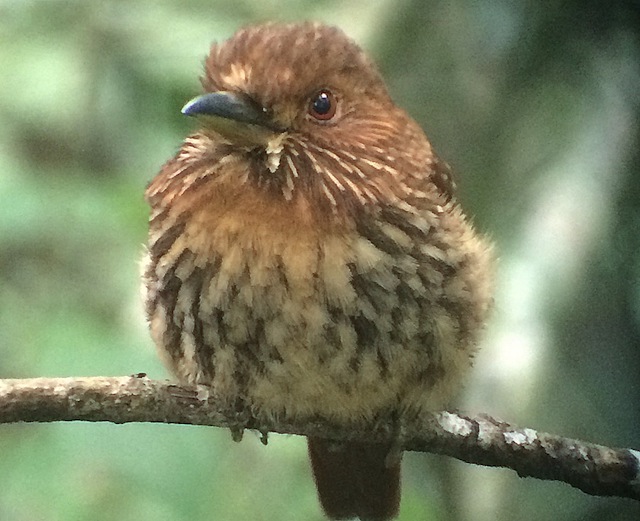
Trips a bit further afield allowed us to really delve into flycatcher id, with Rusty-margined Flycatcher performing particularly well and to admire birds like these gaudy Collared Aracaris and an array of hummingbirds including the stunning Crowned Woodnymph.
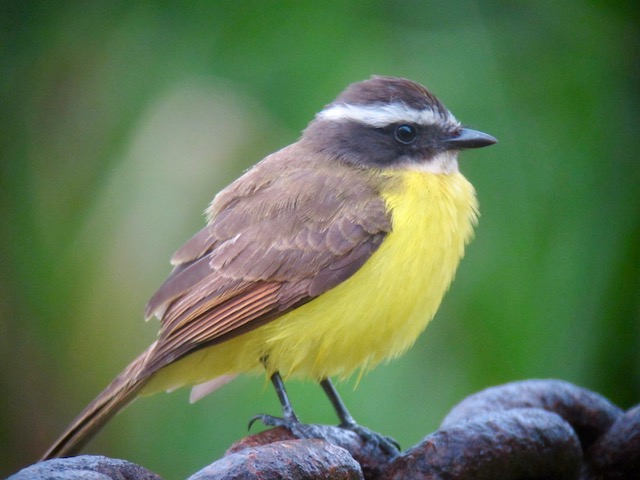
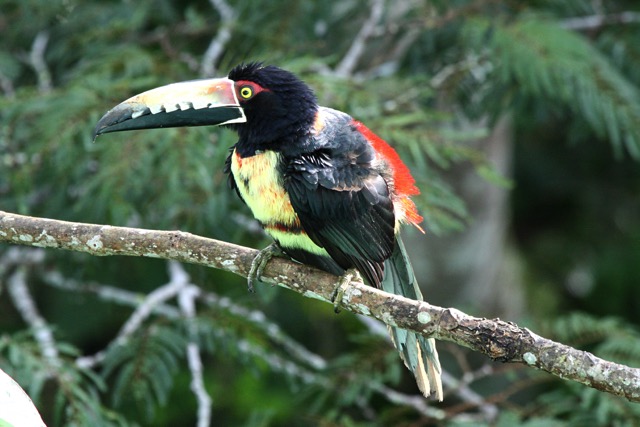
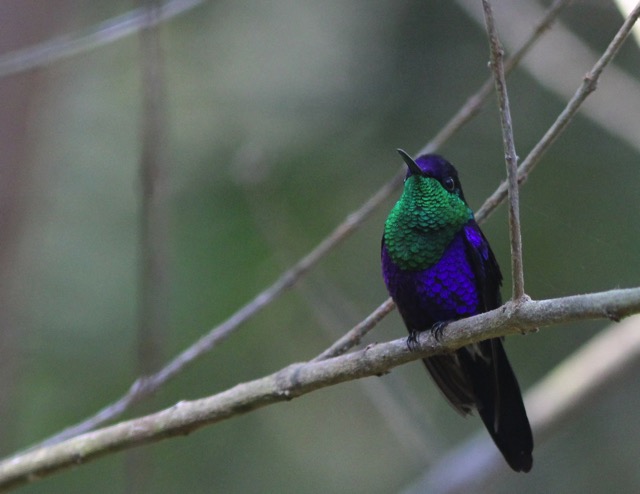
As is always the case in the mammal-rich canal area (where hunting is virtually non-existent) we found a nice array of mammals, including this posing Brown-throated Three-toed Sloth.
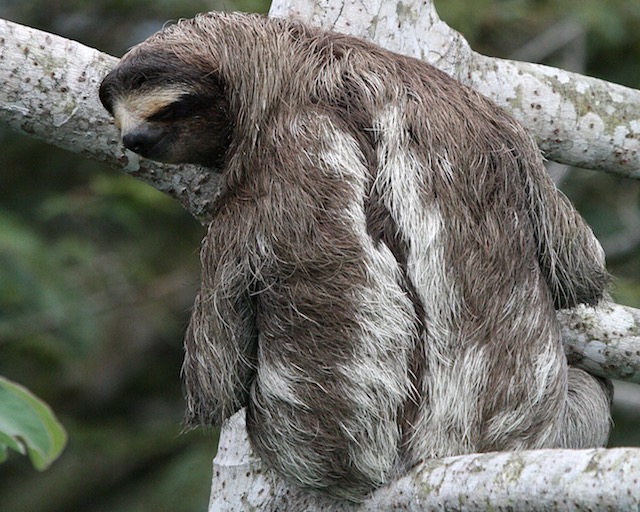
This tour continues to impress me, as the diversity and richness of the region, paired with ease of access and the comforts and uniqueness of the tower make for a truly wonderful experience.
November 28:
Luke Seitz on the second part of his and Fabrice Schmitt's tour, Chile: Tierra del Fuego to the Atacama desert
After adjusting to stable dry land once again, we continued our Chilean adventure by driving high into the Andes – quite a change of scenery from the Humboldt Current! Here, with beautiful snow-capped peaks towering above us and shrubby slopes extending below, we enjoyed the oversized feet of Moustached Turcas running around in plain view…
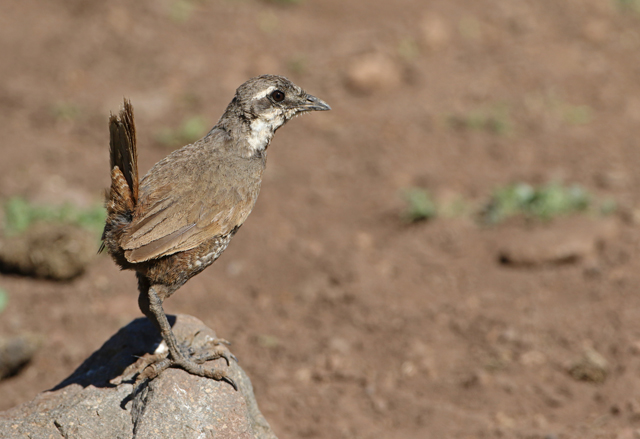
Moustached Turca, the real Big Foot
…and higher up, a simply astonishing show with at least a dozen Andean Condors soaring at eye-level and perching on various hotel rooftops!
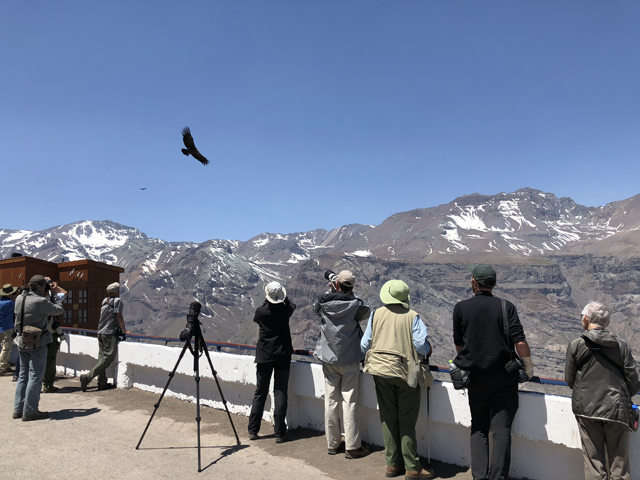
Part of our group being monitored by an Andean Condor
Our time in Central Chile was nearly over, but not without a search for the much-desired Diademed Sandpiper-Plover. The bogs in the Yeso Valley high above Santiago provide perfect habitat for this special shorebird, and it didn’t take us long to find an incubating male that we enjoyed at close range. Surely one of the highlight birds of the trip, with a spectacular backdrop to boot…
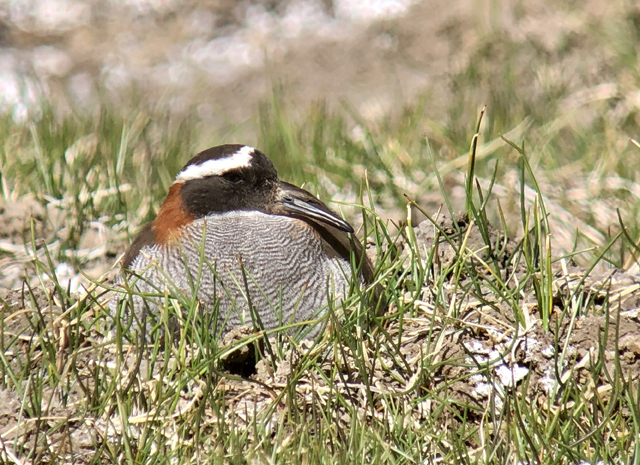
Diademed Sandpiper-Plover
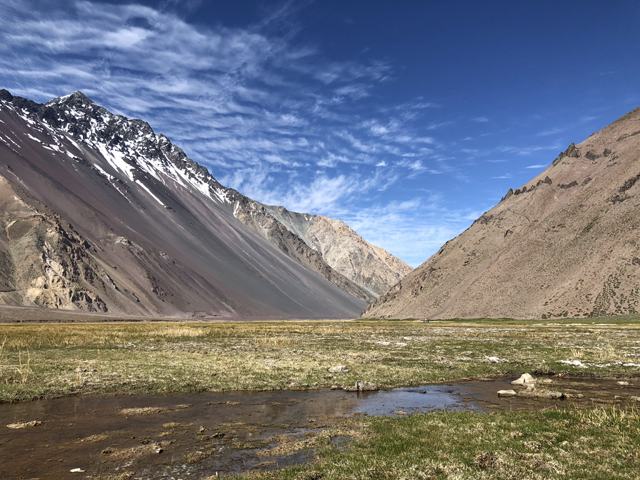
Magnificent Andes scenery
A flight north over the Atacama Desert brought us to Arica, ready for a new suite of birds in very different habitat. The drive from Arica to Putre through dry, lifeless desert was interesting more for geology than birds, but perhaps most incredible was the speed at which our bus traveled uphill – I could have made it to Putre faster by handstand-walking with my eyes closed. Upon arrival, however, we settled in to a surprisingly comfy hotel surrounded by flocks of Mourning Sierra-Finches, skulky White-throated Earthcreepers and Canyon Canasteros, and stealthy Ornate Tinamous running through the nearby fields. The following days of high-elevation birding held a great number of highlights, including a trio of Puna Tinamou, over a dozen Rufous-bellied Seedsnipe, great views of three species of flamingo (Andean, Chilean, and James’s), well-named Giant Coots, Andean Avocets…the list goes on and on.
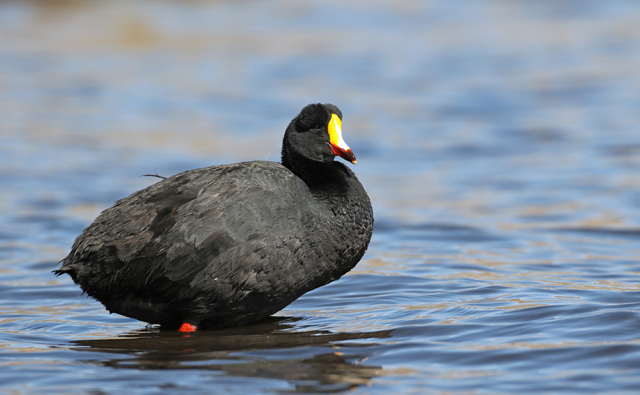
Giant Coot
All too soon it was time to head back to the coast, but not without a final day of birding before the end of our tour. The critically endangered Chilean Woodstar was seen very well on our morning in the Camarones valley – who knows how much longer we’ll be able to find this species? We then visited the Lluta Estuary on our final afternoon, where we were treated to a breathtaking spectacle of 12,000+ Elegant Terns (a sizeable percentage of the world population!) and gobs of Gray Gulls, Franklin’s Gulls, and various migrant shorebirds. What a way to finish a great tour!
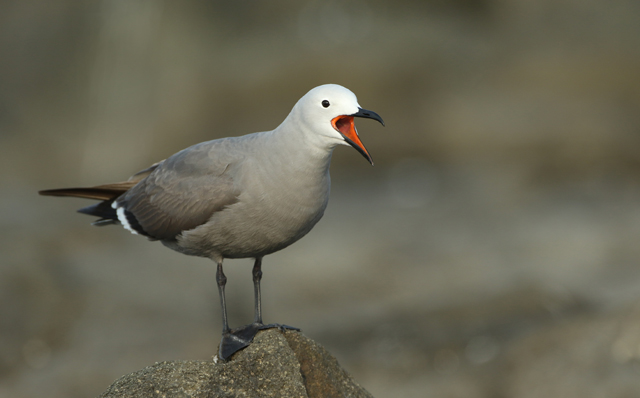
Gray Gull
November 26:
Jake Mohlmann on his recently completed tour, Northern Argentina: High Andes, the Chaco and Iguazú Falls
We recently completed another successful tour around Northern Argentina and ended up finding 462 species of birds as we travelled just over 2000 kilometers through the Yungas cloud forests, arid Altiplano, dry Chaco Woodlands, and wet lowland Rainforest. Birds, butterflies, and mammals abounded as we enjoyed near perfect weather with cool nights for sleeping and warm days for hiking.
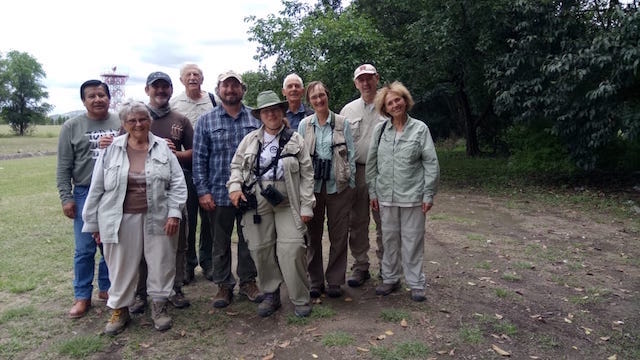
Our group ready to tackle the Andes
It’s really no surprise why the Red-crested Cardinal, actually a tanager, graces the cover of Argentina’s most popular field guide. At Costanera Sur we all got great pictures as one sat and sang very close for several minutes as the light was slowly fading.
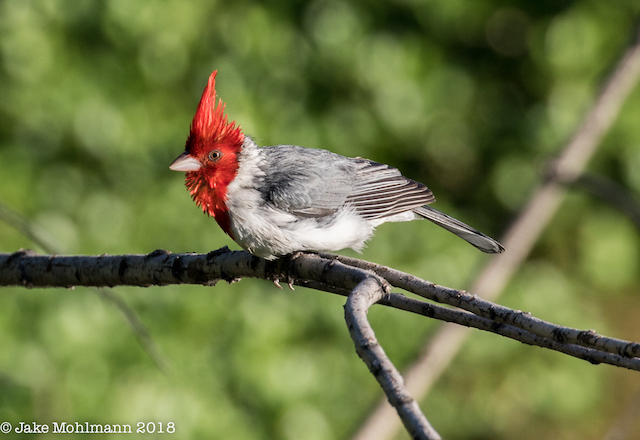
The striking Red-crested Cardinal
It's worth noting that we saw the entire family of Cariamidae, or the Seriemas. In the transition zone between the hot steamy Yungas forest and dense Chaco a group of four Red-legged Seriemas popped out of the trees right beside our van and we watched in amazement as they slowly stalked through the short grass looking for lizards. Nearby below the towering cliffs of scenic Juramento Canyon we ran into a Black-legged Seriema and watched as it repeatedly burst into treetop ‘song’ in territorial defense.
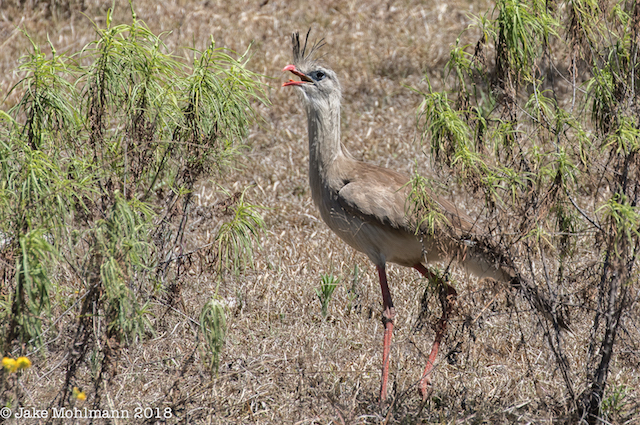
Red-legged Seriema searching for food
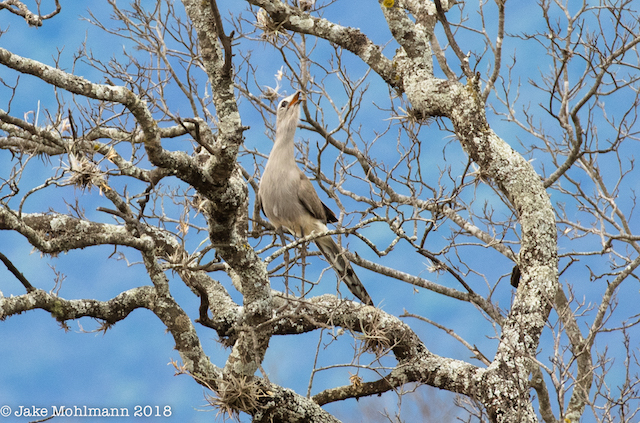
We got goose bumps hearing this Black-legged Seriema scream
Hummingbirds were one group that put on quite the show this year. An amazing 19 species were recorded including the small but bright Slender-tailed Woodstar, no less than five Giant Hummingbirds, and several gaudy male Red-tailed Comets. We even added the electric Blue-tufted Starthroat to the cumulative species list.
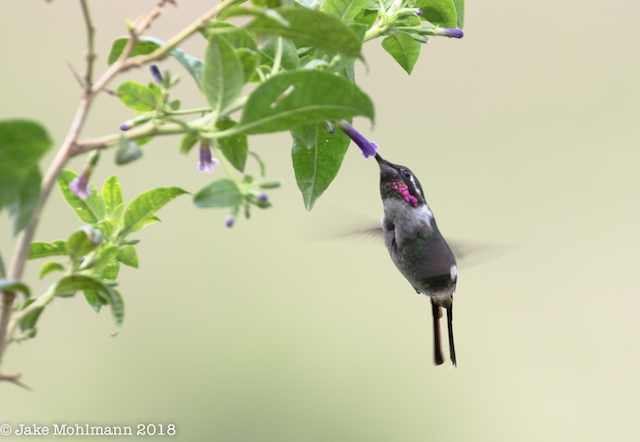
A brilliant male Slender-tailed Woodstar
We lucked into spotting a Black-and-chestnut Eagle nest high on a hillside and watched as the adult tended to the recently hatched young. Perhaps a young of last year from this very nest was the individual that kept us in awe as it soared overhead catching a thermal.
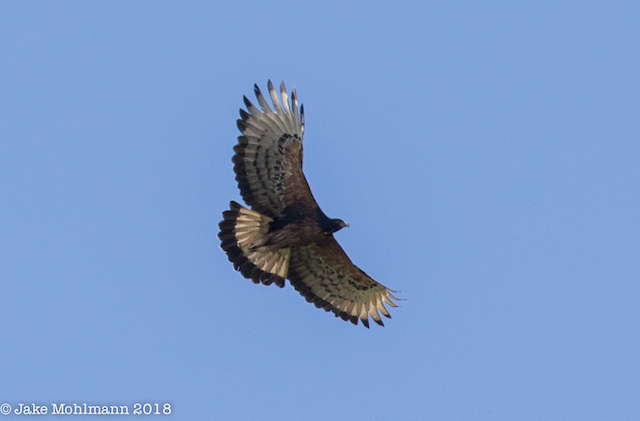
A Black-and-chestnut Eagle glides overhead.
As we gained elevation in the high Puna habitat we scoured several side canyons each with their own interesting species. A short stroll down a two-track on the Bishop’s Slope caused us to flush 30 Bare-eyed Ground-Doves that left in a flurry. Luckily one of them decided to check us out before leaving and posed on a rock wall long enough for all to see the vibrant orange facial skin of this Argentine endemic.
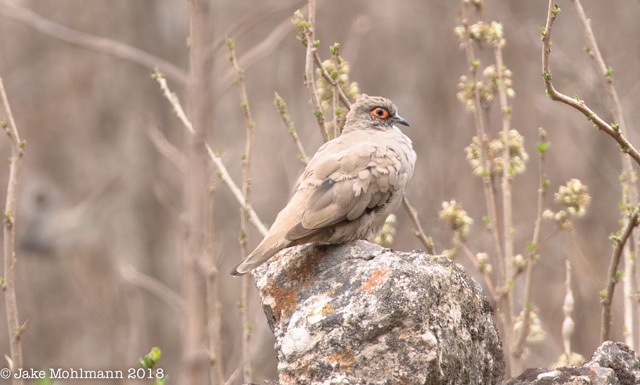
The endemic Bare-eyed Ground-Dove
At elevations exceeding 12,000 feet saline lakes harbored an abundance of birds that choose to breed in this remote location. Three species of Flamingos; Andean, Chilean, and James’s all fed shoulder to shoulder in the briny brew. Puna Teal, Puna Ibis, and Puna Plovers were only found here and a major highlight was a roadside Andean Avocet with drastically curved bill.
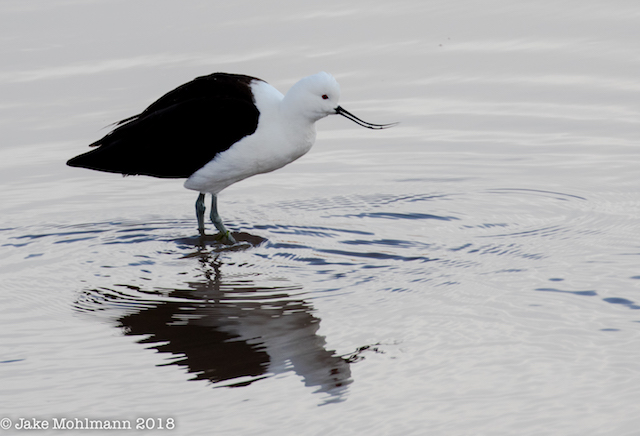
The amazing bill of an Andean Avocet.
Spending our last three days amidst the moist rainforests around Iguazu was a great way to end our trip. The flow rate of the Iguazu River was the highest I’ve seen and provided a dramatic setting as it poured over the hundreds of cascades. It always amazes me how the Great Dusky Swift manages to shoot in through the torrent and find their nest’s location every time.
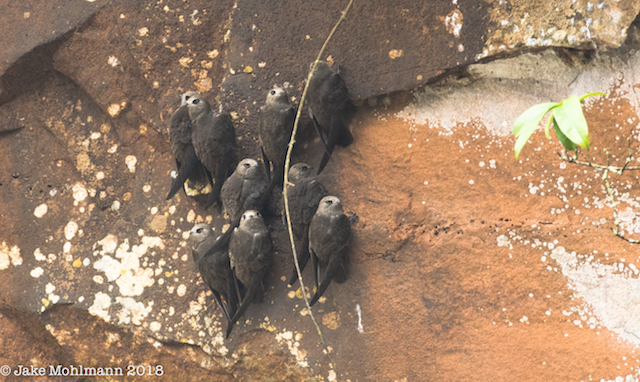
Great Dusky Swifts cling to the rocks behind Iguazu Falls.
A slight change in itinerary this year gave us access to the hill-country east of the falls and ended up allowing us to add 10 new species to the cumulative list! Such delights here were Araucaria Tit-Spinetail, White Woodpecker, Planalto Tapaculo and surprisingly good looks at the secretive Riverside Warbler.
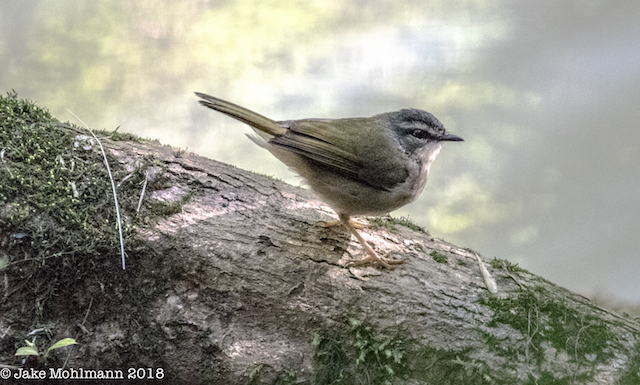
An unusually good look at a Riverside Warbler
November 16:
Gavin Bieber on his recently completed tour, Australia: Victoria and Tasmania
The first half of our tour involves taking a large loop around the state of Victoria (and a bit of New South Wales). For the inland portion of the tour we concentrated mainly on the giant mallee parks of Northwestern Victoria where we delightful and repeated views of Splendid and White-winged Fairywrens, as well as pairs of Major Mitchell’s Cockatoos prospecting for nesting sights, active Sand Goannas crossing the tracks in front of us, tame Emu and a few subtle but exquisitely colored Regent Parrots.
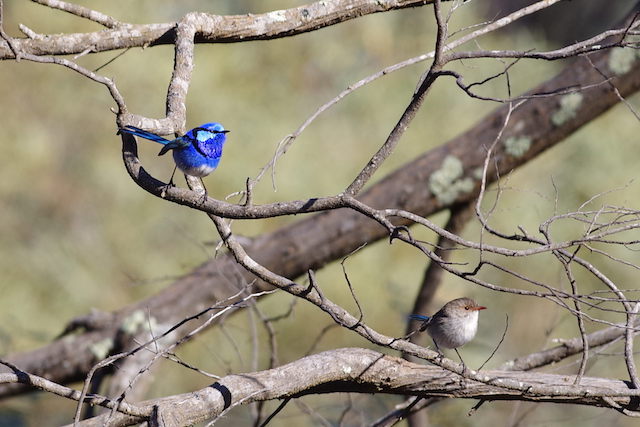
Splendid Fairy-Wren Image: Kent Andersen
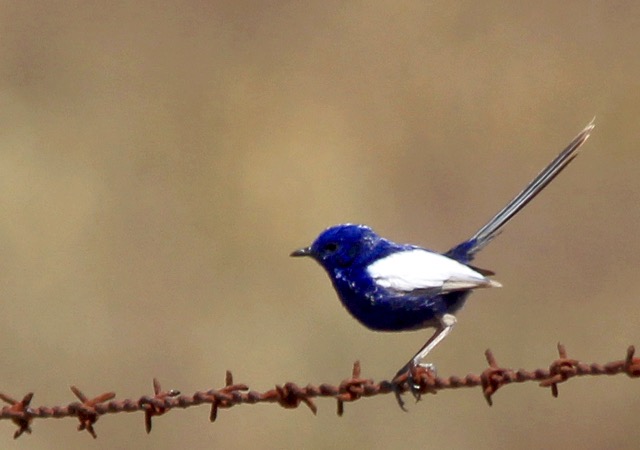
White-winged Fairy-Wren
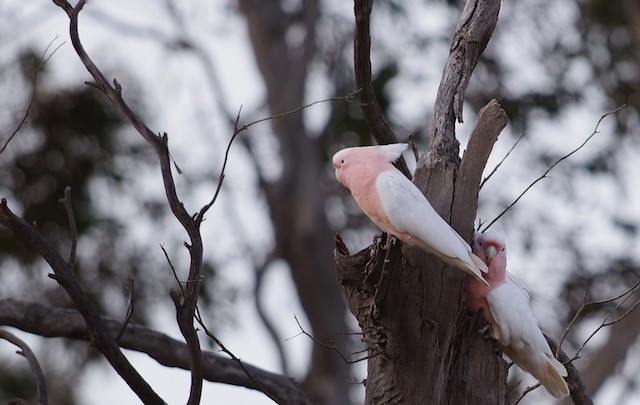
Major Mitchell Cockatoo
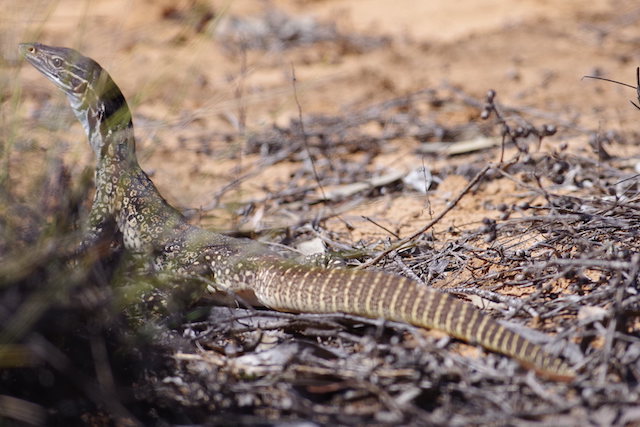
sanD Goanna Image: Kent Andersen
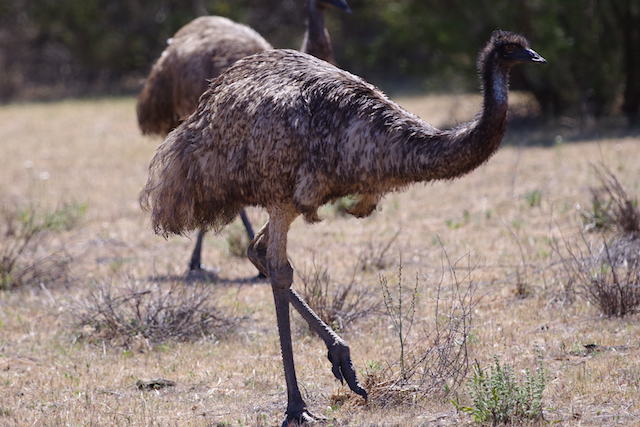
Emu Image: Kent Andersen
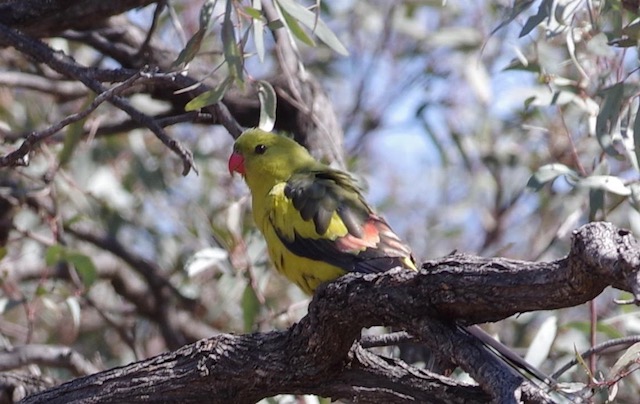
Regent Parrot Image: Kent Andersen
On the arid Hay Plains of central New South Wales the historic drought was still in full swing. Perhaps due to the incredibly dry conditions our hoped-for Plains-Wanderers had wandered off, but our time around Deniliquin was still well spent with an excellent sighting of Fat-tailed Dunnart and a very cooperative Inland Dotterel, as well as truly awesome desert sunsets. Before reaching the coastline we also spent a few days around Little Desert, where the beautiful Malleefowl performed well on its mound and a perky Scarlet Robin kept our cameras busy for quite some time.
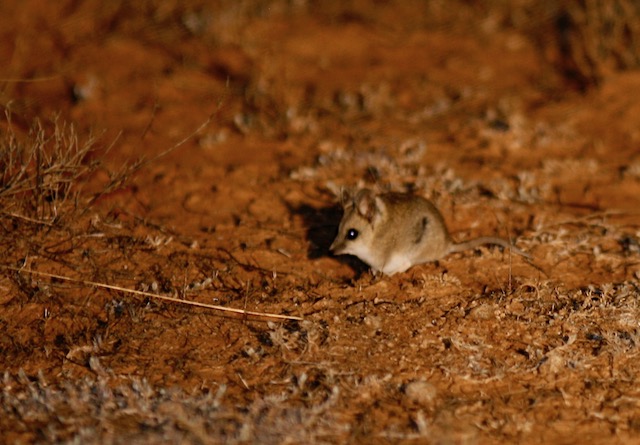
Fat-tailed Dunnart
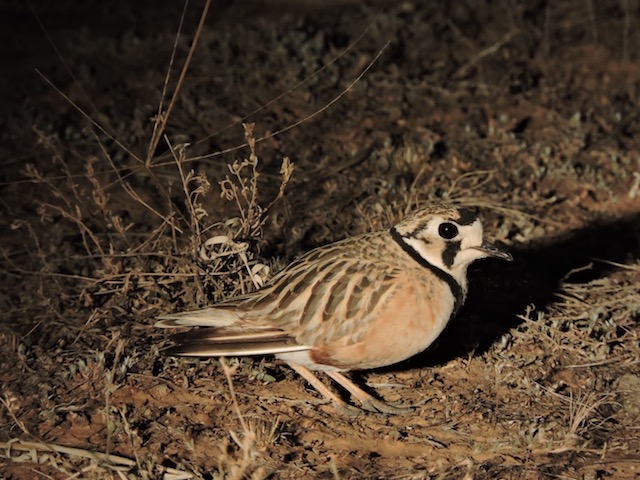
Inland Dotterel Image: Kent Andersen
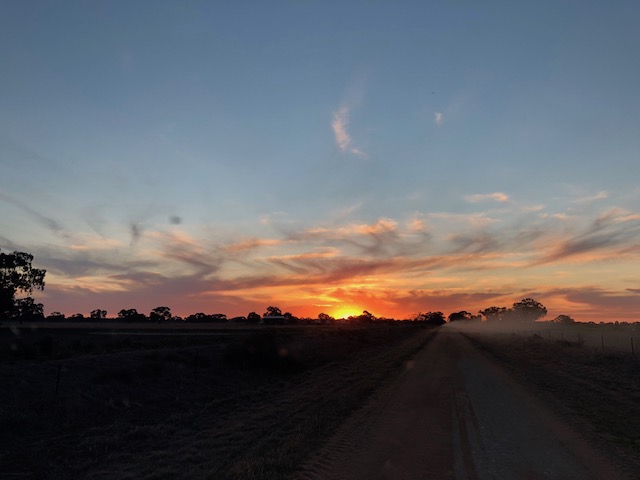
Inland sunset
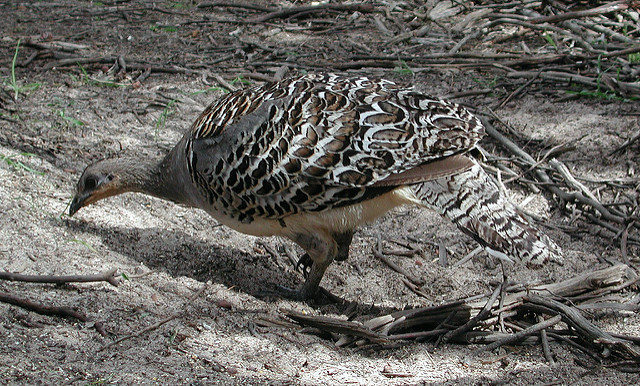
Malleefowl
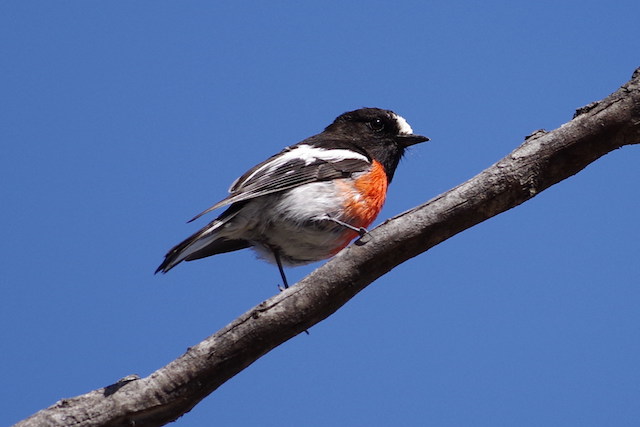
Scarlet Robin Image: Kent Andersen
The second half of the tour concentrates on the remarkably scenic Victoria coastline, a wonderful mixture of weathered cliffs and sea stacks like the famous twelve apostles, white sand beaches like Killarney Beach, and around the city parks of Melbourne, repeatedly voted the most livable city in the world.
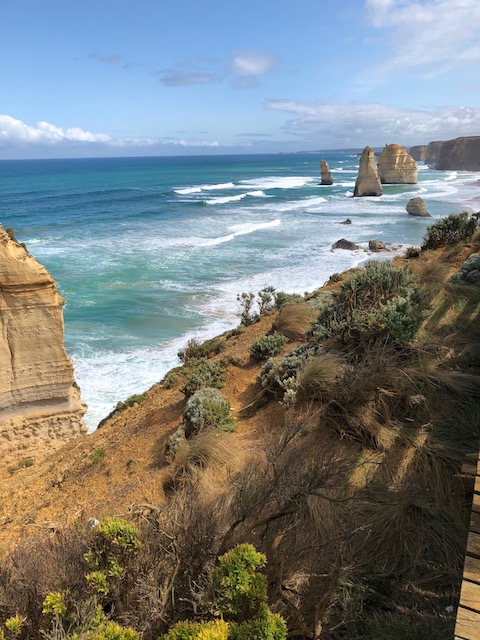
Twelve Apostles
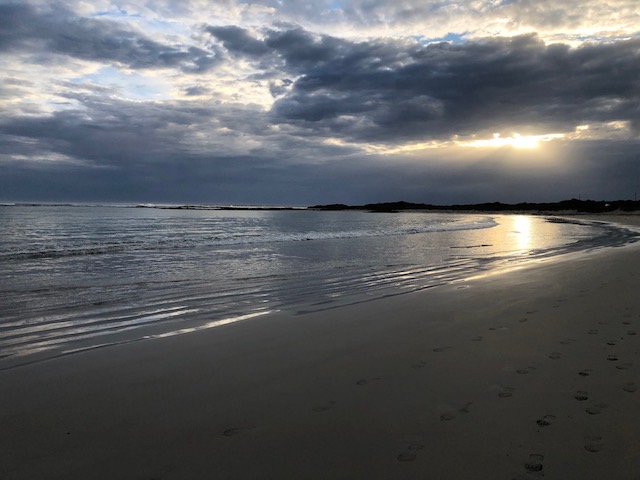
Killarney Beach
We began the tour around the city, with signature Australian birds like the gaudy and inquisitive Rainbow Lorikeet, and the tame Laughing Kookaburra. As always, the varied mammals of the continent feature prominently, from the huge male Eastern Grey Kangaroo to camps of Grey-headed Flying Foxes along an urban creek.
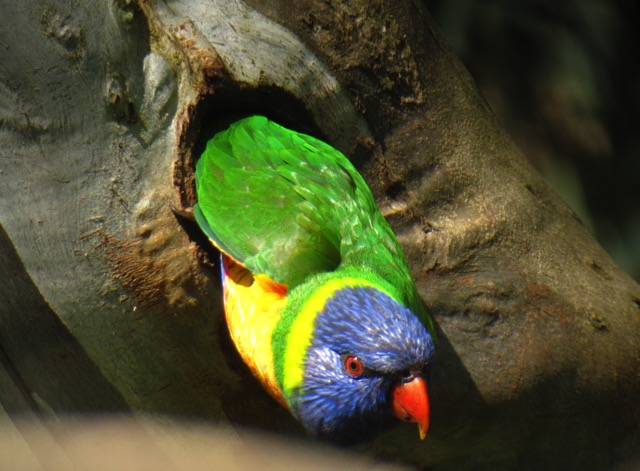
Rainbow Lorikeet
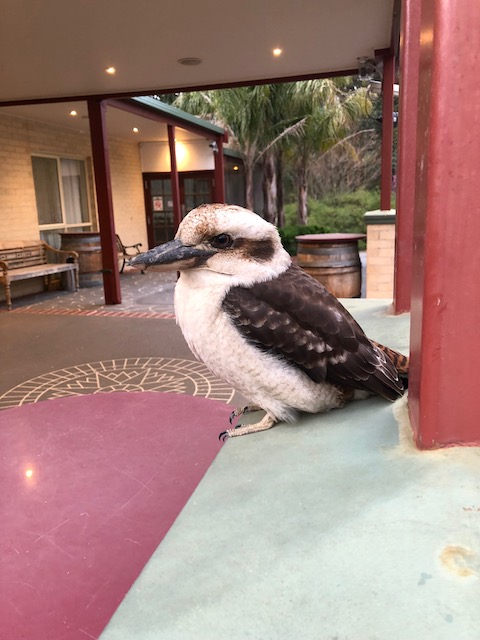
Laughing Kookaburra Image: Kent Andersen
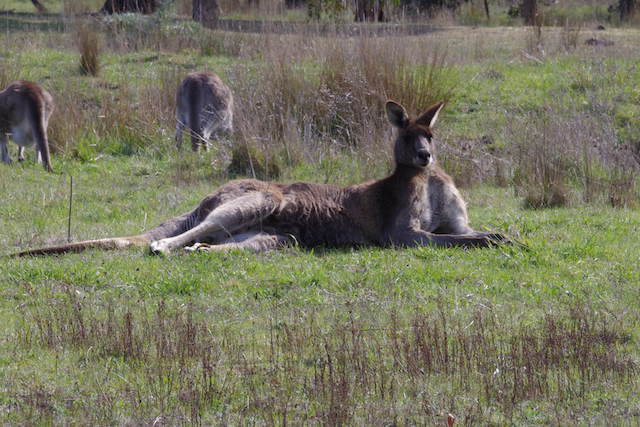
Eastern Grey Kangaroo Image: Kent Andersen
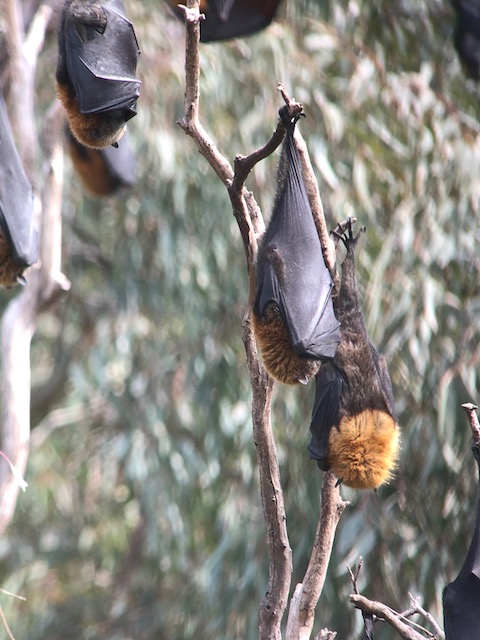
Grey-headed Fying Fox Image: Kent Andersen
Our final few days of the tour are spent in Tasmania, where we located all of the Tasmanian endemics, enjoyed intimate views of the critically endangered Swift Parrot, found our only Little Penguins of the trip and a nice array of waterbirds that included a vagrant Hudsonian Godwit, this handsome Black-faced Cormorant (our 5th species of Cormorant for the tour), the menacing Pacific Gull and this diurnally active and undeniably cute Echidna.
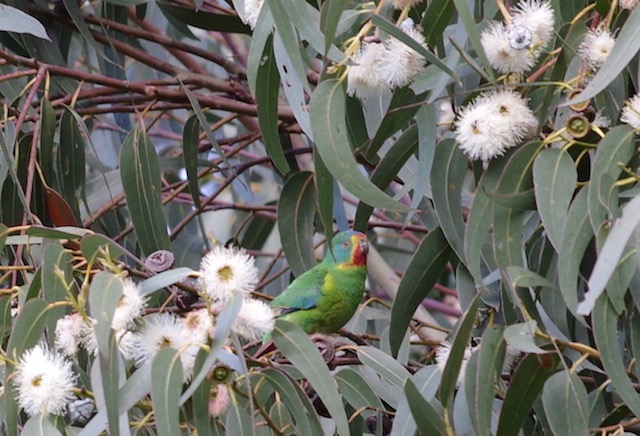
Swift Parrot Image: Kent Andersen
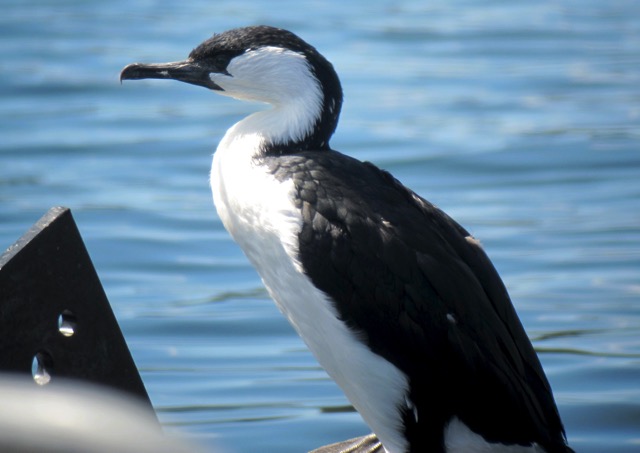
Black-faced Cormorant
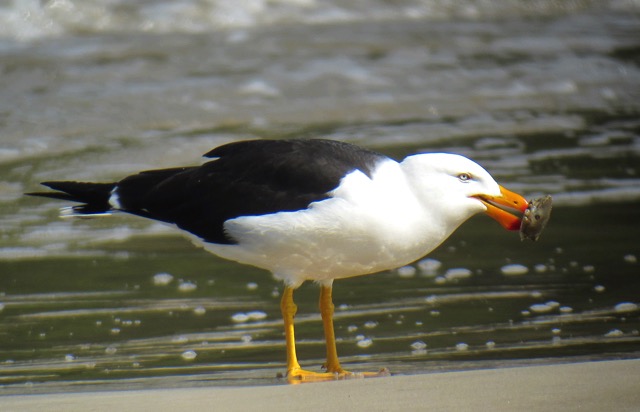
Pacific Gull
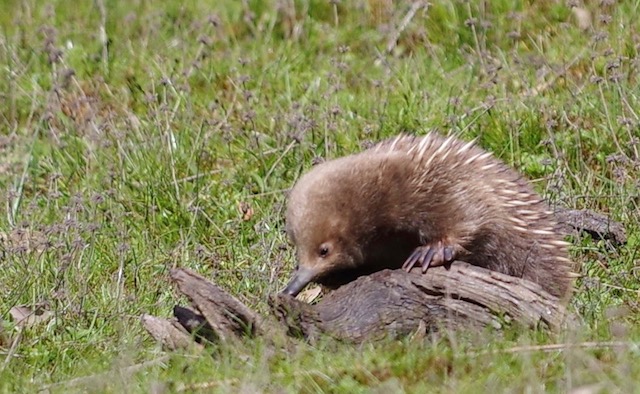
Echidna Image: Kent Andersen
We wrapped up the trip with an impressive 284 species of birds and 21 mammals, both records for the trip. With the breadth of wildlife and scenery this tour never fails to deliver, and I very much look forward to returning to this corner of the country in 2020.
November 14:
Gavin Bieber on the first part of his recently completed tour, Australia: Queensland and New South Wales
We kicked off with a fantastic week around Cairns and the Atherton Tablelands, the region which hosts the highest diversity of species in the country, including many of the continent’s signature birds. We had wonderful experiences with many of these this year. Just a sampling of our favorite sightings would includ a family group of Southern Cassowaries lounging in the afternoon sun, displaying Australian Bustard strutting on a lek site, glaring Metallic Starlings at a nesting colony, jewel-like Spotted Pardalotes attending a nest, multiple male Victoria’s Riflebirds gorging themselves on fruit on our first morning above the lodge carpark and a stunning Azure Kingfisher along the scenic Daintree River. Tours to Australia are never solely about the birds; this year around Cairns we found multiple Boyd’s Forest Dragons, incredibly tame and impossibly cute Mareeba Rock Wallabies and even a couple of the enigmatic Lumholtz’s Tree Kangaroos!
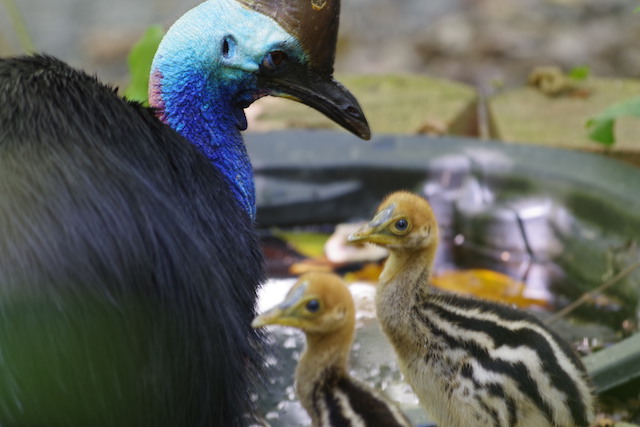
Southern Cassowary Image: Kent Anderson
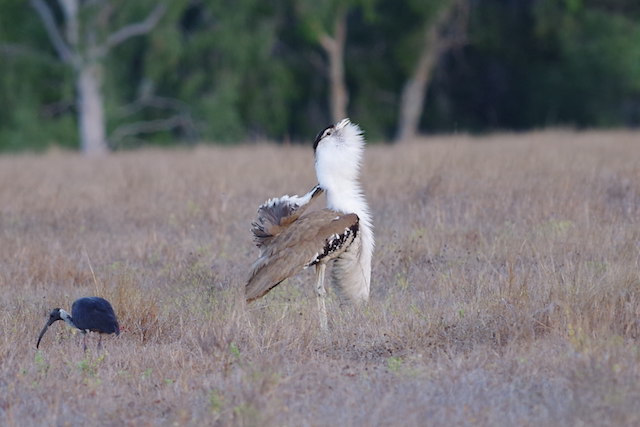
Australian Bustard Image: Kent Anderson
Metallic Starling
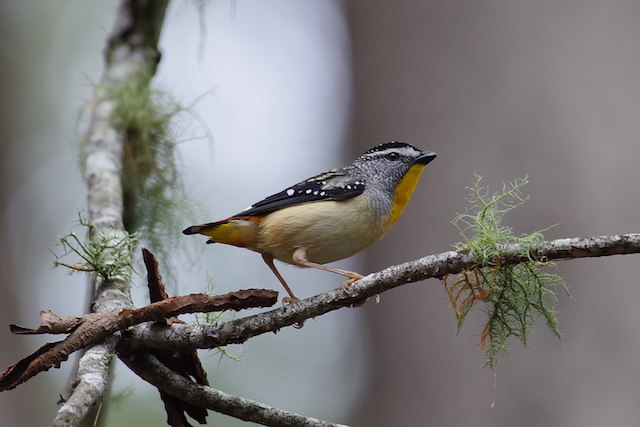
Spotted Pardalote
Azure Kingfisher
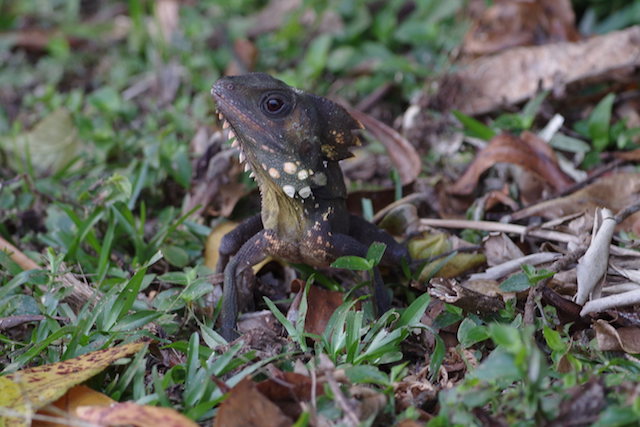
Boyds Forest Dragon Image: Kent Anderson
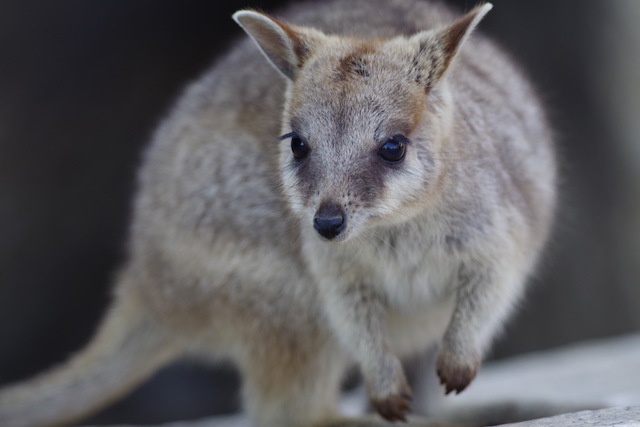
Mareeba Rock Wallaby Image: Kent Anderson
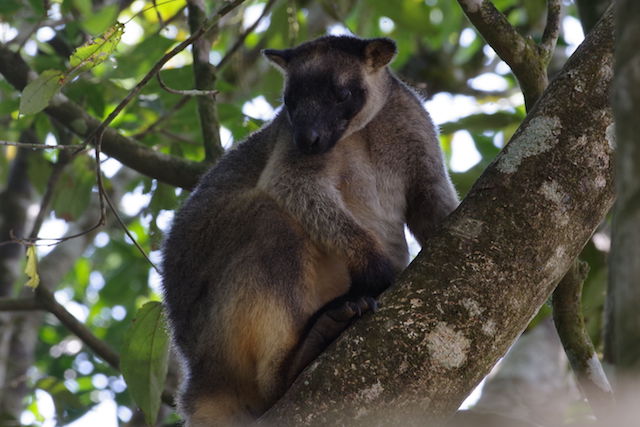
Lumholtz Tree Kangaroo Image: Kent Anderson
November 12:
Luke Seitz on his and Fabrice Schmitt's ongoing tour, Chile: Tierra del Fuego to the Atacama Desert
Fabrice and I are just over halfway finished with our Chile tour, and we’re having a great time. Birding started out hot on our first afternoon in Punta Arenas when this male Magellanic Woodpecker dazzled us with stunning views just along the roadside.
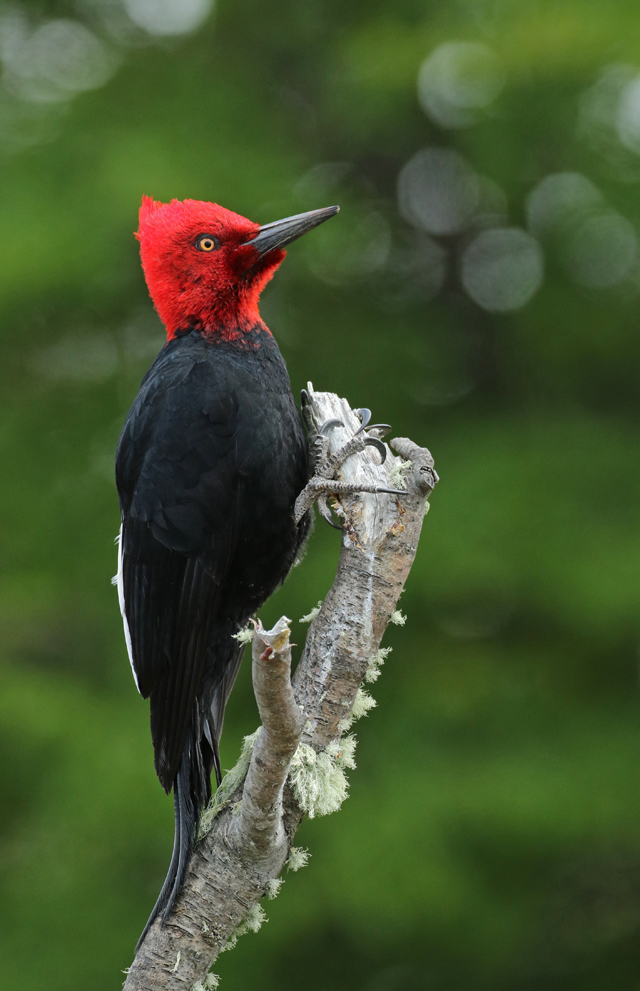
We then spent a couple days exploring the windswept Patagonian grasslands, seeing nearly all of our target birds in the process: Chocolate-vented Tyrant, Rufous-chested and Tawny-throated Dotterels, Magellanic Plover, and of course, the now-famous colony of King Penguins south of Porvenir. This unexpected Spectacled Duck was particularly photogenic…
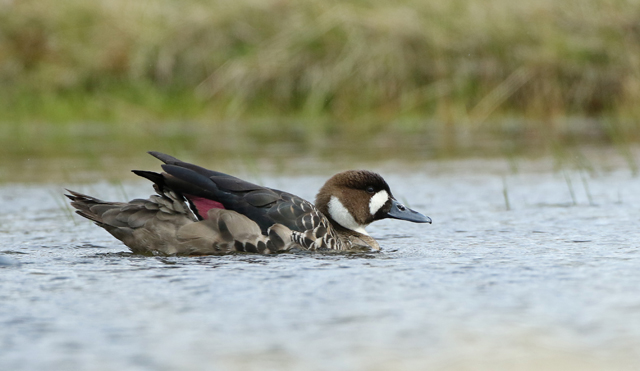
…but we were also thrilled to find a trio of Patagonian Tinamous along a dirt road near Punta Arenas, one of which crouched down and allowed us to soak in its intricate pattern at leisure. This was the first time Fabrice had seen this species in Chile!
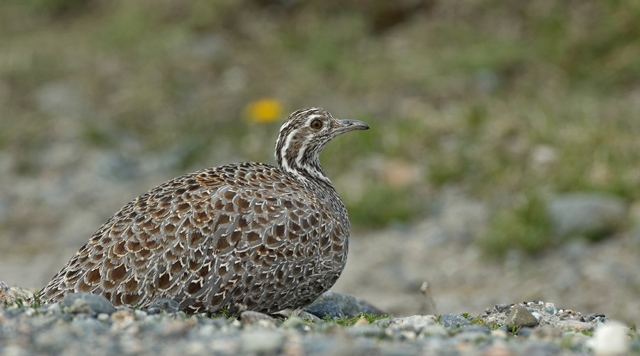
Flying north to Puerto Montt, we headed up into the rainy hills for some forest birding. Chile is well-known for its spectacular tapaculos (atypical of the family!), and our time searching for these skulky birds paid off. Chucao Tapaculo in particular performed brilliantly, zipping around nearly at our feet! Pardon the blurry photo, it’s dark in the bamboo-choked forest…
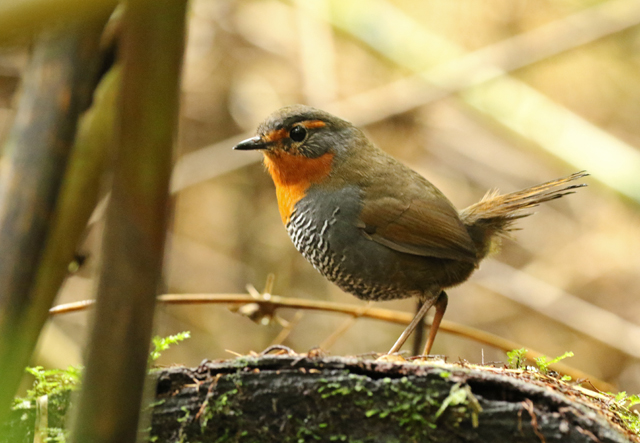
Heading further north, we had two days to check various spots along the coast. Highlights including White-throated Tapaculo, Great Shrike-Tyrant, and close Inca Terns kept us busy, but today was arguably one of the best days of the entire tour. We boarded a boat and headed into the cool waters of the Humboldt Current, where we were treated to a spectacular show of dozens of albatross (among other seabirds), including the rare Chatham Albatross pictured here. Check out that big yellow bill! We’re back in Santiago now, excited to head up into the Andes for more specialties in the coming days…
